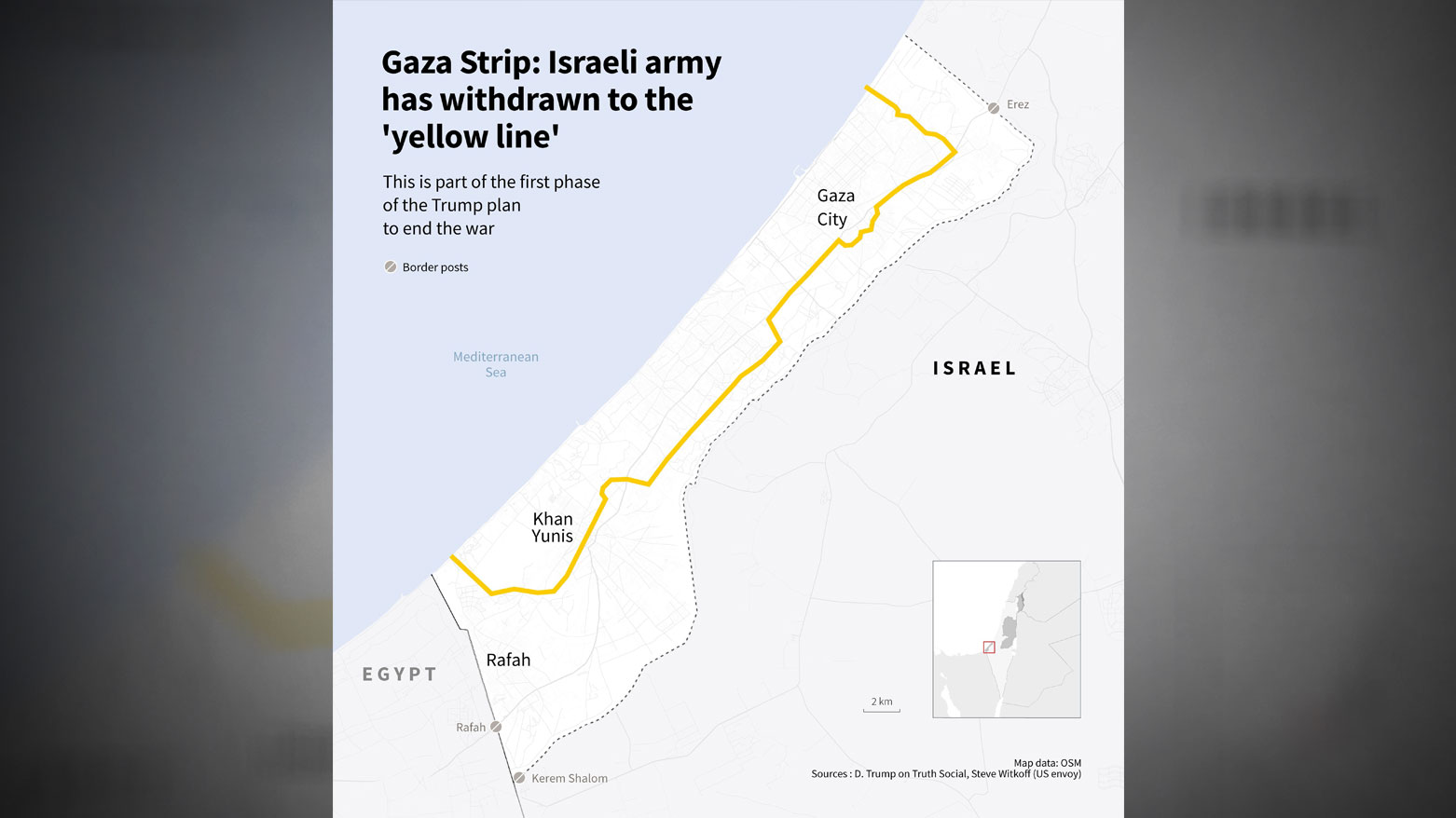U.S. Drafts Plan to Divide Gaza Between Israeli and Hamas Control
The U.S. is drafting a plan to divide Gaza between Israeli and Hamas control, with reconstruction focused solely on Israeli-held areas until Hamas disarms.

ERBIL (Kurdistan24) – A new U.S.-backed proposal being discussed between Washington and Tel Aviv would effectively divide the Gaza Strip into two separate zones—one controlled by Israel and another by Hamas—with reconstruction efforts focused solely on the Israeli-controlled side until Hamas is disarmed and removed from power.
The plan, described by The Wall Street Journal, represents one of the most consequential post-war frameworks under consideration since the fragile ceasefire was reached last week in Sharm El-Sheikh.
Speaking during a joint press conference in Israel on Tuesday, Vice President JD Vance said Gaza currently consists of “two zones—one relatively safe and one extremely dangerous,” adding that the U.S. goal was “to expand the safe zone geographically.”
former White House advisor Jared Kushner, who, according to The Wall Street Journal, outlined the economic vision behind the plan, stated that no reconstruction funds would go to areas still under Hamas control.
“Until the area can be secured, reconstruction will focus entirely on the safe side,” he said. “We are considering building a new Gaza in the Israeli-controlled area to provide Palestinians with a place to live, work, and rebuild their lives.”
According to U.S. officials quoted by The Wall Street Journal, the concept aims to create a temporary framework to stabilize part of the enclave while negotiations continue over disarmament and the formation of a transitional governing authority capable of overseeing the full reconstruction of Gaza.
One senior administration official described the plan as “preliminary,” noting that updates will be provided “in the coming days.”
Arab mediators have expressed deep concern over the proposal, warning that it could cement a permanent Israeli security zone inside Gaza. Cairo and Doha, both central to the U.S.-brokered truce, reportedly oppose any arrangement that formalizes division within the enclave.
Regional diplomats told The Wall Street Journal that no Arab nation is likely to accept monitoring or policing responsibilities in Gaza under such conditions, fearing it would imply tacit recognition of long-term Israeli control.
At the heart of the debate lies the unresolved question of how to disarm Hamas and form a legitimate authority capable of restoring civilian governance and attracting international investment. The U.S. envisions a “phased reconstruction model” backed by Gulf donors, conditional upon sustained stability and the exclusion of Hamas from political power.
Sources familiar with the talks said Jared Kushner—who previously led the Trump administration’s 2020 “Peace to Prosperity” plan—is now the driving force behind the divided-reconstruction initiative.
Kushner reportedly crafted the proposal in coordination with U.S. Special Envoy Steve Witkoff, who has been shuttling between Jerusalem and Cairo to coordinate mediation efforts. Officials confirmed that Kushner briefed President Donald Trump and Vice President Vance, securing their full backing before the plan was presented to Israeli leaders this week.
The new U.S. initiative comes amid an unprecedented wave of high-level visits by American officials to Israel.
Israeli government spokeswoman Shosh Bedrosian confirmed Tuesday that U.S. Secretary of State Marco Rubio will arrive in Israel on Thursday, marking his third visit since mid-September. Rubio is scheduled to meet Prime Minister Benjamin Netanyahu on Friday to discuss the ceasefire and the reconstruction framework.
“This reflects the hand-in-hand relationship between Israel and the United States at this historic time,” Bedrosian said.
Vice President Vance and Special Envoy Witkoff are already in Israel promoting the plan, while Egypt’s intelligence chief Hassan Rashad is also holding talks with Israeli and U.S. officials to stabilize the truce.
Rubio before departing for Israel warned that the Israeli Knesset's approval of bills aimed at extending Israeli sovereignty over the occupied West Bank could "threaten" the ceasefire in the Gaza Strip.
"I think the president has emphasized that this is not something we can support right now," Rubio told reporters. He noted that the approval of any of the bills before the Knesset would "threaten" the ceasefire and "be counterproductive."
The Knesset voted on Wednesday to debate two bills aimed at extending Israeli sovereignty over the occupied West Bank.
US President Donald Trump, who supported Israel in the Gaza war, has expressed his opposition to its annexation of areas of the West Bank, an idea supported by the Israeli far right. Trump said in September, "I will not allow Israel to annex the West Bank. No, I will not allow it."
On Wednesday, Knesset members voted on two bills in preliminary reading, a vote that paves the way for their first reading.
The first bill, proposed by Avigdor Lieberman, leader of the nationalist opposition party Yisrael Beiteinu, was approved by a majority of 32 to nine. It aims to extend Israeli sovereignty to the Ma'ale Adumim settlement, which has a population of over 40,000 and is located just east of Jerusalem.
The second bill, proposed by right-wing opposition MK Avi Maoz, was approved by a majority of 25 to 24. It aims to extend Israeli sovereignty over the entire West Bank, which Israel has occupied since 1967.
Media reports indicated that Israeli Prime Minister Benjamin Netanyahu instructed his Likud party members to abstain from voting.
Commenting on the two bills before the Knesset, Rubio said that "Israel is a democracy. They will vote on them."
He added, "But at the moment, we believe that this may not be effective."
Asked about the escalation of violence by extremist Israeli settlers against Palestinians in the West Bank, Rubio said, "We are concerned about anything that threatens to destabilize our efforts."
Despite these tensions, Washington insists that its goal remains the same—to maintain the ceasefire, disarm Hamas, and create conditions for a “new Gaza” that can eventually reunify under a non-militant governance structure.
As reconstruction debates intensify and Arab resistance grows, the U.S.-Israeli proposal highlights the deep divisions over Gaza’s future—between those seeking pragmatic stability and others warning that such plans risk institutionalizing a fractured and divided Palestinian territory.
